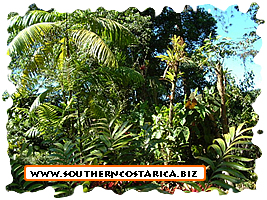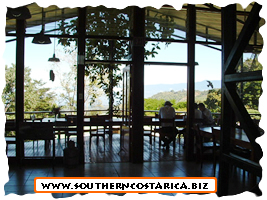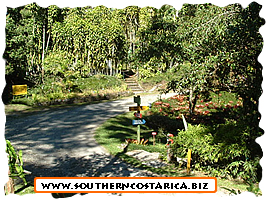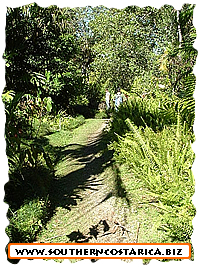The Robert and Caterine Wilson Botanical Gardens
The Robert and Caterine Wilson Botanical Gardens
Created in 1962, The Botanical Gardens were named in honor of their founders
Robert and Catherine Wilson; a North American couple who were originally owners
of the Fantastic Gardens in Miami, Florida. This couple decided to make a botanical
garden with an emphasis on tropical plants. They spent more than 10 years planting
the garden, the design very much influenced by a well known landscaper and artist
Roberto Burle Marx.
For a long time this garden was called Jardín Las Cruces.
An Australian, Stanley Smith gave a lot help to the garden, and in 1967 donated funds to build a scientific station which is now named after him, and serves to lodge students and scientists studying natural sciences and horticulture.

In 1973, the Wilsons signed an agreement with OET/OTS (Organization of Tropical
Studies) known for their excellent administration of study sites.
In 1984 Catherine Wilson died, and the gardens were partially abandoned until,
in 1986 Robert signed a new agreement with OET so that the organization of Tropical
Studies assumed all rights to the Gardens and the authority to manage them.
Later he passed away.
HOW TO GET THERE
Take the Panamerican highway south. 15 km beyond the customs post "El Brujo", you cross Rio Grande de Térraba and head to San Vito.
The Gardens are 5 km from San Vito on the road to Agua Buena. There are gas stations in Buenos Aires and San Vito.
TOPOGRAPHY
It is surrounded by uneven ground covered with secondary vegetation.
SIZE
The Robert and Catherine Wilson Gardens covers 12 hectares dedicated to ornamental horticulture.
CLIMATE
It is a moderate climate allowing a great diversity of plants to be grown. Dry season is from January to March and during rainy season, the area is covered with dense fog.
TEMPERATURE
The average temperature is 21°c during the day dropping to 17°c in the
night. Annual rainfall is close to 4.000 m.m.
CHARACTERISTICS OF A BOTANICAL GARDEN
 Botanical Gardens vary widely in terms of their activities, financing and objectives, but they all must complete with the following characteristics:
Botanical Gardens vary widely in terms of their activities, financing and objectives, but they all must complete with the following characteristics:
• Stability
• A scientific base to make collections
• Monitoring and labeling of plants
• Open to the public
• Exchange of information, plants, and seeds, with other gardens
• Scientific investigation of plants
• Maintenance of such investigation
This garden is actually known as The Robert and Catherine Wilson, Las Cruces Botanical Gardens in honor of its founders.
CHARACERISTIC OF THE ROBERT AND CATHERINE WILSON BOTANICAL GARDENS
The Garden has a collection of international exotic tropical plants as well as more than 4.000 species of native plants and the largest variety of palms in the world, with 700 species. The grounds are filled with ferns, palms, bromeliads and heliconias, such that it is considered the most important in Central América, comparable with the  "Farichild" in Florida and the Rio de Janeiro Botanical Gardens in Brazil.
"Farichild" in Florida and the Rio de Janeiro Botanical Gardens in Brazil.
There are 12 hectares dedicated to ornamental horticulture, picnic areas, view points, experimental parcels, nurseries, the Stanley Smith Station (private lodging) hydroponics (the cultivation of plants without soil) paths and trails.
The Botanical Garden has survived the deforestation and agricultural development common to this region; and with its active community programs, is an ideal place for the study of agro- ecology and the biology of conservation, as well as a site of
extraordinary scenic beauty and tourist potential.
FLORA:
Within the grounds of the garden and the vicinity, only a few inventories of the plant and animal species have been made. However, the Botanical Garden has several thousand of tropical plants species from all over the world making it one of the best tropical plants collections in the world.
Also 250 fungus species have been collected, and more than 100 species of plant parasitic fungi. The number of fern species is estimated at about 100 and of larger plants and tress, about 2000 species. Within the garden, there is a forest containing some 500 native tree species and an abundance of mosses, bromeliads and epiphytes.
FAUNA:
Within the area, there is a variety of wildlife; more than 3 000 species of butterflies and moths have been collected and more than 400 other species of insects. Around the study station alone 50 different may bug species has been recorded. 40% of the native bird species can be seen here, of the 275 species 208 are resident, 49 migratory and, 18 visiting. 70% of the native amphibious species like toads, frogs, reptiles, and small lizards have been recorded here. Finally, close to 80 mammal species are represented including howler and white faced monkeys, ant eaters, sloths, dante, armadillos, etc. (including 44 bat species).
 There are many trails.
There are many trails.
Primary trails:
• Heliconia trail.
• Bromeliad trail.
• Rio Java trail.
• Natural History trail.
Secondary trails:
• Maranta trail.
• Orchid trail.
• Bamboo trail.
• Water trail.
More info at phones (506) 773-3278/7734004
Fax: (506) 773-3665.
E-mail: lcruces@hortus.ots.ac.cr
Be the first to comment on this listing!